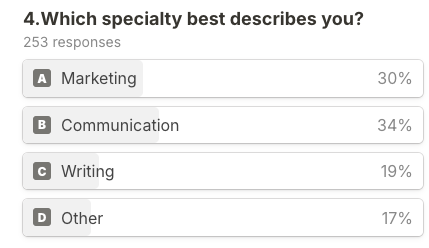Whenever I follow a publication or independent author, I’m always curious about how they’ve built their platform and what their life looks like behind the scenes. That’s why I decided to share a bit of my own journey—both as a way to reflect and to give you a transparent look at what’s been going on behind the curtain.
I’ll structure this post like an FAQ, answering the kinds of questions I've usually been asked when I talk about The Science Marketer.
Let’s start!
So, how is The Science Marketer going so far?
Pretty well, I must say.
I launched The Science Marketer on September 28, 2023, with the goal of becoming “the go-to resource for actionable advice and tips in science marketing and communication.” After one year of publishing, I believe I’ve managed to attract a fair amount of attention, bringing me closer to that goal each day.
To be honest, I didn’t have huge expectations when I started. The newsletter began as a passion project. I love to write, and with my experience in science marketing and communication, I simply felt compelled to start sharing what I know.
The only goal I set for myself was to be consistent—publishing every week, with a break here and there for holidays.
On that front, I’ve done pretty well. So far, I’ve written 44 posts, averaging around 1,900 words each—that’s over 84,000 words in a year (about the same length as Harry Potter and the Chamber of Secrets)!
If you’ve followed my posts, you know I’m a big believer in consistency as the key to success in content marketing. So I’m glad to say I’ve practiced what I preach.
What’s even better is that the time I’ve invested in writing seems to be paying off. I’m receiving more and more positive feedback from readers, and although it’s hard to quantify, I feel like the perception and reception of my work has improved, especially over the past six months.
So, first of all, thank you for sharing your thoughts with me—whether positive or critical! You can’t imagine how much your feedback motivates me and helps me improve.
I also feel like The Science Marketer launched at just the right time. Before starting, I searched for similar content, but nothing really stood out. There are fantastic people sharing insights on LinkedIn, but nothing that dives as deep as a 1,900-word article.
What’s also exciting is that the topics I cover seem to resonate with a wide range of audiences. While marketers and communicators are my core audience, I’ve noticed that people in business development and even science writers are interested in what I have to say.
So far, over 700 people have subscribed to my newsletter, which is about what I expected for the first year. But what really surprised me is that my website has had over 13,000 visitors in the past year, and that’s much more than I anticipated.
That’s a lot of potential for the future, and I’m pretty excited about it!
What have you learned during the first year?
I’ve definitely learned a lot this year, and I’ve experimented as much as possible with what I want to offer through The Science Marketer.
First, the format of the newsletter simplified pretty quickly after the first few months. Initially, I had big ambitions—I started with a weekly article, along with a curated list of links and job offers in science marketing. While I didn’t mind doing it, I soon realized that the articles were getting far more attention than the additional content. So, I decided to focus solely on writing even better, more in-depth articles.
Another gradual shift was in the topics I covered. Early on, I wrote a lot more about science writing, but over time, I leaned more heavily toward science marketing.
The reason is that I’m from both worlds. As the founder of Labiotech, I had to write and work with writers on a daily basis, but I also had to be in charge of marketing our media or helping the many advertisers who worked with us to promote their own offerings. After some reflection, I realized that my strengths and insights were more valuable on the marketing side.
Besides, others are already doing a fantastic job covering science writing (shout-out to the Science Writing News Roundup by Marianna Limas and The Open Notebook, two of my personal favorites).
A few months in, I also started organizing online calls with my readers. Initially, the idea was to share my expertise on specific topics and answer questions from the audience. But after two sessions, I realized that format wasn’t helping me grow—I wasn’t learning as much as I wanted, and frankly, I didn’t enjoy just hearing the sound of my own voice. So, I pivoted to interviewing people I wanted to learn from.
This led me to interview great science marketers like Amber Penrose, Steve Harvey ,Christopher Caudle and Marina Hop. Interviewing people is something I’ll definitely continue, especially since 62% of readers requested more interviews in my latest survey.
Another milestone this year was landing my first advertising deals. Given the small size of my audience, the revenue wasn’t huge, but it was a valuable experiment in refining the business model for The Science Marketer. Thanks to the brands that trusted me! From the conversation I had with them, the feedback was positive, but growing my audience will definitely help attract more deals in the future. Even though it’s not my first preoccupation at the moment, I’m still open to advertising, so if you're interested, you can check out my advertising page.
What did you find challenging this year?
Aside from juggling my various roles and finding time to write each week, there were a few other challenges I had to face.
When I first launched the newsletter, I published it both via email and through LinkedIn’s newsletter feature. I won’t dive into the details here since I’ve already written about why I stopped using the LinkedIn newsletter feature, but in short, the cons outweighed the pros. I decided to focus on more sustainable growth, even if that meant taking a few steps back initially—like the fact that I’m potentially leaving behind over 2,000 subscribers.
Then there is another challenge that’s still torturing me: it’s so damn hard to find good case studies in science marketing! I’ve been eager to find great examples to showcase and analyze, but they’re surprisingly rare. A significant chunk of time goes into searching for real-life examples, especially in the life sciences space. It’s frustrating, but I’ll keep looking—and I may need to broaden my scope to include other sectors when sharing marketing campaigns with you.
Another ongoing challenge is to find the time to develop new things related to the newsletter. I have a long list of ideas and features I’d love to implement, but realistically, most weeks, I’m stretched to my limit just getting an article published.
For example, I’ve always enjoyed educating and sharing knowledge, so creating a course or hosting a workshop is definitely high on my list of priorities. It’s also the most requested feature from my readers, based on the survey results.
Hopefully, I’ll manage to put something together in the coming year!
What do my readers want?
I love surveys, and since launching The Science Marketer, I’ve conducted several to understand better who my readers are and how I can serve them.
Here’s a breakdown of my readers' roles:

While this result is to be expected, I’m still a bit surprised by the high number of people in communication. Of course, marketing and communication are closely linked, but the distinction is important. This has me thinking about how to make sure my content serves both groups more effectively in the future.
When I asked readers about their biggest professional challenges, the responses mainly fell into these categories:
- Generating more leads
- Boosting social media engagement
- Being more creative
- Managing limited time and resources
- Transitioning into science marketing after completing a PhD or master’s degree in science
These answers are consistent with the topics I already cover, so I don't think I'll change too much in the way I choose them (which is basically a mix of ideas I come up with and experiences I think are relevant to share).
The latest survey also highlighted two types of content readers want more of: interviews and case studies. As I mentioned earlier, I’m committed to doing more interviews. Case studies are trickier, but I’m working on it.
You’ve also been incredibly kind in your open comments, with some of my favorites being: “It’s genuine!”, “I learn a lot of new things!”, and “It’s well-written and straight to the point.”
In conclusion, I think I’m on the right track when it comes to content and audience fit. I’ll keep exploring different formats and topics, but it seems like I’ve found a formula that works and provides value.
Where does The Science Marketer go from here?
My first goal for year two is to keep being consistent. I can’t stress enough how crucial consistency is for building a successful publication. So expect to see my email landing in your inbox every Tuesday.
I’m also eager to expand the scope of what I cover, venturing beyond life sciences. I strongly believe that the marketing and communication strategies I discuss aren’t limited to life sciences—they’re equally relevant in other deep-tech industries. So, you’ll likely see more diverse examples and interviews from a broader range of fields.
Lastly, I want to take my time, experiment, and enjoy the process. I’m not making money from this newsletter yet (the ad revenue barely covers the website hosting), and I don’t expect much in the short term. Call it a sunk-cost fallacy, but now I’m into it. I really enjoy writing about this topic, and I love the interaction with this audience, so I’m in this for the long haul, even if it takes a lot of time each week.
If you want to support The Science Marketer, the best thing you can do is recommend it to someone who might find it valuable. Word-of-mouth is an incredible way to grow sustainably, so please take a minute to spread the word.
And of course, feel free to reach out anytime if you have questions or need help with your marketing. I always reply and will do my best to offer useful advice.
Thanks for being a reader of The Science Marketer!





